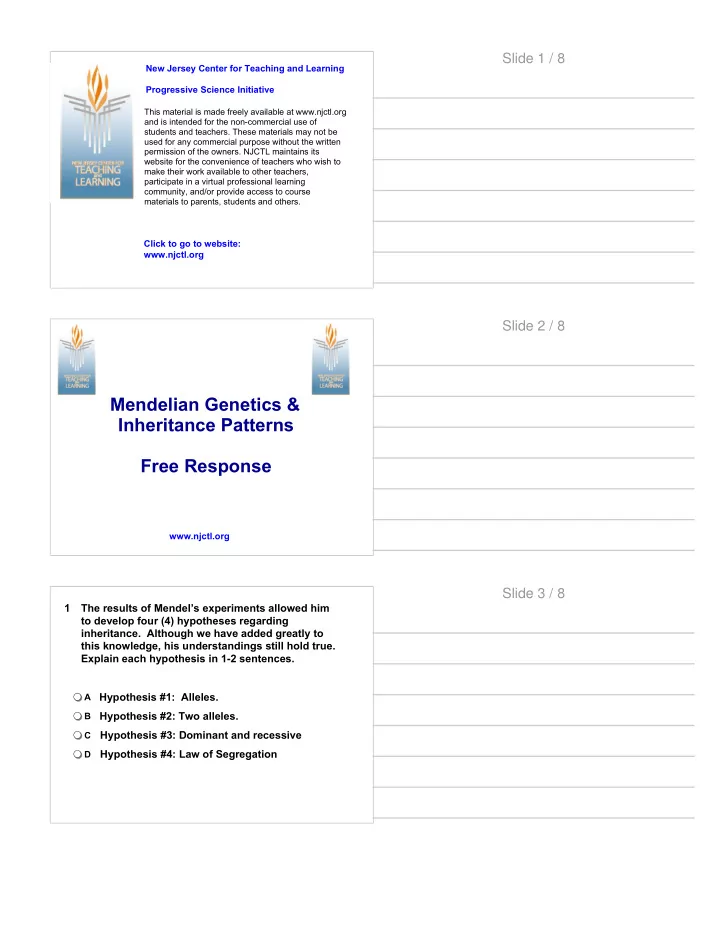

Slide 1 / 8 New Jersey Center for Teaching and Learning Progressive Science Initiative This material is made freely available at www.njctl.org and is intended for the non-commercial use of students and teachers. These materials may not be used for any commercial purpose without the written permission of the owners. NJCTL maintains its website for the convenience of teachers who wish to make their work available to other teachers, participate in a virtual professional learning community, and/or provide access to course materials to parents, students and others. Click to go to website: www.njctl.org Slide 2 / 8 Mendelian Genetics & Inheritance Patterns Free Response www.njctl.org Slide 3 / 8 1 The results of Mendel’s experiments allowed him to develop four (4) hypotheses regarding inheritance. Although we have added greatly to this knowledge, his understandings still hold true. Explain each hypothesis in 1-2 sentences. A Hypothesis #1: Alleles. Hypothesis #2: Two alleles. B Hypothesis #3: Dominant and recessive C Hypothesis #4: Law of Segregation D
Slide 4 / 8 2 Two mice heterozygous for the long tail gene are crossed (P generation). Let T = long tail and t = short tail. These mice have 18 offspring, some which have long tails and some that have short tails. A Draw a Punnett Square illustrating the cross of the parental generation) B We want to select out the mice with long tails, but only the ones with the genotype of TT. Which mice will you cross? C What possible results will you get from your cross? (show your Punnett square(s)). D What result do we get if we have a true breeding long tailed mouse? E What do we call this type of experimental crossing? Slide 5 / 8 3 Two dihybrid plants are crossed. Let R = allele for red flowers; r = allele for white flowers; T = allele for tall plants; t = allele for short plants. The inheritance of these alleles exhibits complete dominance. A What is the probability for offspring that are RRTT: (show all work) B What is the probability for offspring that are RrTt: (show all work) Slide 6 / 8 4 Two trihybrid plants are crossed. Let R = allele for red flowers; r = allele for white flowers; T = allele for tall plants; t = allele for short plants; B = big flowers; b = small flowers. The inheritance of these alleles exhibits complete dominance. A What is the probability for offspring that are RRTTBb: (show all work) B What is the probability for offspring that are RrTTBB: (show all work)
Slide 7 / 8 5 Male patterned baldness cannot be determined by observing the hair pattern of a man’s father. This is because this trait is a recessive sex-linked trait. Using the letter B to represent the not bald allele and b to represent baldness, allele respond to the prompts below Because this is a sex-linked trait, what will be the symbol you will use for a female who is a carrier for male A patterned baldness? B Because this is a sex-linked trait, what will be the symbols you will use for a male who is not bald? C Show the cross between such a female and a male, using a Punnett square. D What is the percent probability that this couple will have a child with male patterned baldness? E What is the percent probability that, given they have a male child, the child will have male patterned baldness. F What is the percent probability that, given they have a female child, the child will have male patterned baldness. Slide 8 / 8 6 A pedigree is shown below. Refer to this pedigree to respond to the prompts below. https://migrc.org/Library/Sexlinked A Is the X-linked trait indicated by the darkened circles and squares, dominant or recessive? For each individual within the pedigree (1-15) write in the line below the genotype (don’t forget the Xs). Use the B letters B and b to indicate the allele. (there are two possibilities for individuals 10 and 12) For the man labeled as #11 above, if he has children with a woman who does not exhibit the x-linked trait, what is the C percent probability they will have a child who will exhibit the trait? For the man labeled as #11 above, if he has children with a woman who does exhibit the x-linked trait, what is the D percent probability they will have a child who will exhibit the trait?
Recommend
More recommend